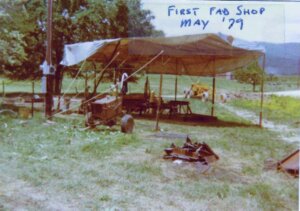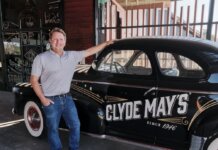
In 1979, three men set up a flimsy tent cover in a field near Oxford and began working on one of the world’s heaviest materials.
That was the humble beginnings of FabArc Steel Supply, which in the ensuing decades has forged itself into becoming the largest steel fabrication subcontractor in Alabama. FabArc is now a $300 million-plus company with a production capacity expected to reach 46,000 tons this year. And all this happened without ever leaving that original plot of ground just off I-20.
“It is amazing to think about how this company started and what it has become since then,” FabArc Senior Vice President Justin Cox says. “We have pretty much been under constant expansion since 1979.”
Initially, expansion for FabArc did not mean much more than sticking a few extra pieces of rebar into the ground and adding another tent covering. The trio of founders — Gene Heathcock, Cary Lewis and David Pugh — began as a company that worked on small fabrication jobs such as farm tools, largely by hand.
“It was just about as much of a small-time startup as you could get,” says current FabArc President and CEO Tom Adams, who first met the company’s founders in the mid-1980s. “They were physically doing the work. They were fabricating steel just like we do today, but in a crude fashion.”

Slowly but steadily, one successful job led to another, and then to a dozen more. As FabArc grew so did the work, as the company began creating the steel skeletons for increasingly larger structures, all while transitioning its area of focus based upon changes in the marketplace.
Many of FabArc’s earliest major projects involved hospitals and medical facilities. Then in the late 1990s, the company shifted gears and became heavily involved in the expansion of the auto industry into Alabama and other Southern states.
“Over the last 25 to 30 years, we’ve been one of the top builders of automotive manufacturing in the country,” Adams says. “We’ve worked for almost every car manufacturer that has a facility in the U.S. BMW, Honda, Mercedes, GM, Ford, Chrysler, Subaru, Hyundai, Kia. It’s been a big part of our business.”
More recently, FabArc has seen an increase in work involving electric-vehicle battery plants. For example, FabArc currently is helping in the creation of a $1.9 billion plant near Memphis in Marshall County, Mississippi, that will produce battery cells for commercial electric vehicles.
FabArc Senior Vice President Richard Hughes says the facility is “massive,” spread out over 2 million square feet and requiring 30,000 tons of fabricated steel. The plant contains columns and beams that weigh more than 500 pounds per foot, and trusses that top 20 tons each. The company simultaneously is working on a slightly smaller EV plant in Indiana.
“And while we’re doing all that, we’re still taking care of our other customers, the 100- to 500-ton jobs,” Hughes says. “There are bigger fabricators than us, but they have multiple plants. We produce everything out of this one facility.”

At first glance, the FabArc facility does not necessarily look like a multi-million-dollar company capable of handling such large projects. FabArc has fewer than 300 employees working within approximately 300,000 square feet of manufacturing space. A few old houses that have been on the property since before the company was formed are now used as makeshift office space.

But the company’s modest appearance belies the amount of success FabArc has had. Plus, it fits well with the overall ambience of the company, which maintains a family atmosphere partly because there are so many families that have multiple members who work together at FabArc.
“In a lot of ways, this is still a small company,” says Cox, who has been with FabArc for 17 years. “You see a lot of the same people every day. It’s always had that family feel to it.”
In addition, Adams says FabArc embraces its small-town roots by staying closely connected to the Oxford and Calhoun County area.
“Most of our workforce lives probably within 30 miles of here,” Adams says. “This community is a vital part of what we do, so we want to outreach and be an active part of Calhoun County.”
Or as Hughes puts it, “If you live in this area, you know someone who works here, if not several people.”
As a result of all the familiarity and community connections, FabArc leadership decided about a decade ago to begin exploring the possibility of transitioning to employee ownership. Two of the three founders had already retired, leaving Heathcock with nearly 90% ownership of the company, and he was drawing close to a retirement decision as well.
“There came a time when we had to look at how Gene could retire out of the company without bankrupting the company,” says Adams, who joined FabArc in 2012. “By that point his stake in the company was tremendously significant. So, we started talking about an ESOP (Employee Stock Ownership Plan). I’d previously worked for an ESOP company in Kansas City and thought it was a great thing.”
So FabArc started the change in 2017, beginning with 23% employee ownership that year. And just as the company did with its overall growth, FabArc made the transition slowly with no specific timetable in mind. It took seven years, but the company became 100% employee-owned last October.

“There has been a conversation about doing this since I came here (in 2014),” Hughes says. “In a business like this where you are always trying to get talent and retain talent, it helps to tell people that they can be an owner in the company.”
In this case, it is a company that is part of an industry with a long and storied history in Alabama and throughout the United States. The city of Birmingham basically was built by the steel industry. Some of the country’s most iconic structures, such as the Empire State Building in New York and the Gateway Arch in St. Louis, are monuments to the strength and durability of the material. Cox calls steel “the backbone of America.”
“Steel is the most versatile building product out there,” Hughes says. “You can’t create a lot of these shapes with wood or concrete, or these massive spans. We were a sub (contractor) for the Boeing manufacturing facility in Charleston, and we were working on a roof system that had 700-foot-long trusses. What else can you use to do that? Not concrete. It’s just so impressive.”
Adams agrees. “There is a lot of satisfaction in riding by a building that our company worked on,” he says. “It’s like having a plaque in your office that everyone is able to see.”
Cary Estes and Cary Norton are Birmingham-based freelance contributors to Business Alabama.
This article appears in the June 2025 issue of Business Alabama.



